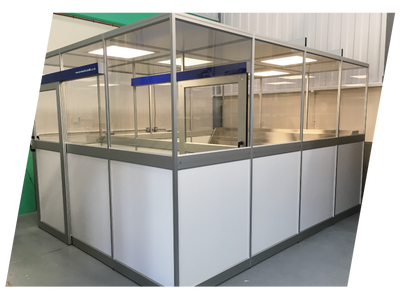Aluminium Modular Cleanrooms
Guaranteed Clean Environments
The area is constructed from free-standing aluminium framework which can be assembled on site in just a few hours. Each framework is designed and manufactured in the UK by our engineers, allowing us full control from concept through to completion.
Our Modular Cleanrooms offer a cost-effective solution to creating a clean area within an existing room or space. Air cleaning filtration device(s) are fixed to the outside walls or ceiling and as air enters the room it is drawn through a HEPA filter (99.997% efficient at 0.3 microns) creating a positive pressure and clean air environment. A variety of levels of cleanliness can be achieved in accordance with ISO Cleanroom Standards; ISO Class 6, 7 or 8 are the most common.
Each Monmouth Cleanroom is entirely bespoke, allowing us to accommodate sizes from small to large scale constructions. All components are manufactured from long lasting and easily cleaned materials to ensure years of uninterrupted service. The construction is lightweight and can be dismantled and relocated if required. With a choice of different size standard elements, a variety of working areas can be constructed. Panel walling is constructed from aluminium composite, to suit requirements, and clear non-break polycarbonate creates window panes.
The Modular Cleanrooms can be built with or without changing/entrance areas. The entrances can be constructed as sliding doors, hinged doors, strip curtains or a combination of the three. If preferred, transfer hatches can be built in to allow the safe and easy passing of items into the clean air environment.
What Is A HEPA Filter?
HEPA stands for High Efficiency Particulate Air. The Institute of Environmental Sciences and Technology dictates that a HEPA filter must trap 99.97% of particulates 0.3 microns or larger.
HEPA filters trap air contaminants in a complex web of fibres. Depending on the size of the particle, this can happen in four different ways: Inertial Impaction, Diffusion, Interception, or Sieving.
Larger contaminants are trapped via inertial impaction and sieving. The particles either collide with the fibres and become trapped or are trapped while attempting to travel through the fibres. Medium sized particles, as they move through the filter, are grabbed by the fibres via interception. Smaller particles are dissipated as they travel through the filter and eventually collide with a fibre and are trapped.
The standard lifespan of a HEPA filter varies between 3 and 5 years in a standard cleanroom environment. This is dependent on the degree of contamination in the environment and maintenance of the pre-filters. The capacity of the fan filter unit (HEPA or ULPA filter) decreases over time as the filter becomes saturated.
An advantage of the HEPA Filter is that as they become saturated with contaminant, airflow capacity decreases and static pressure increases, as a result the filters become more efficient as the filter loads.















